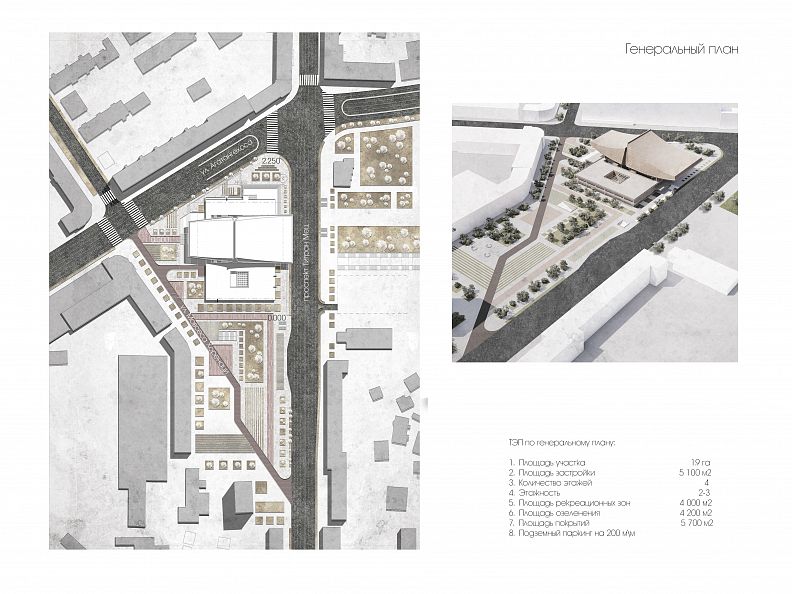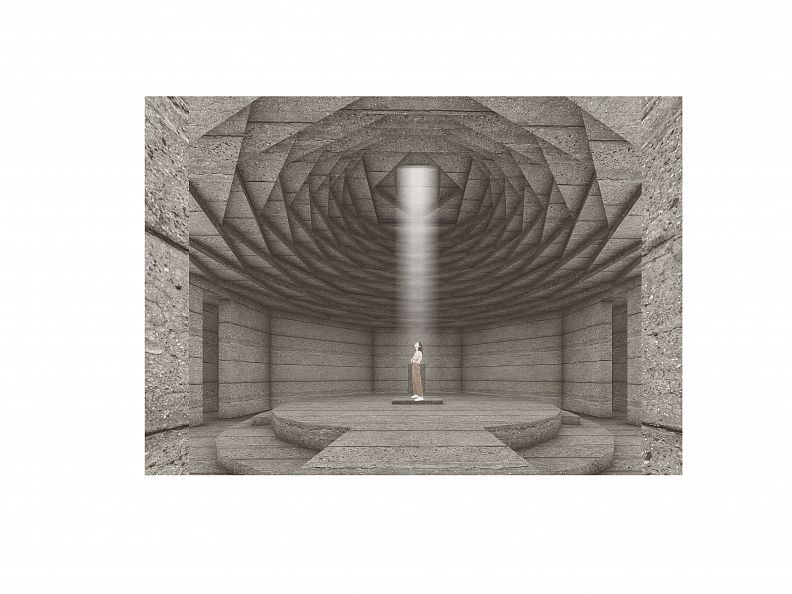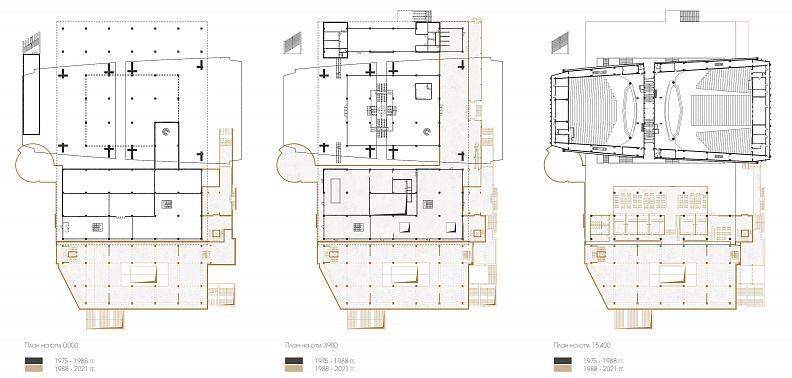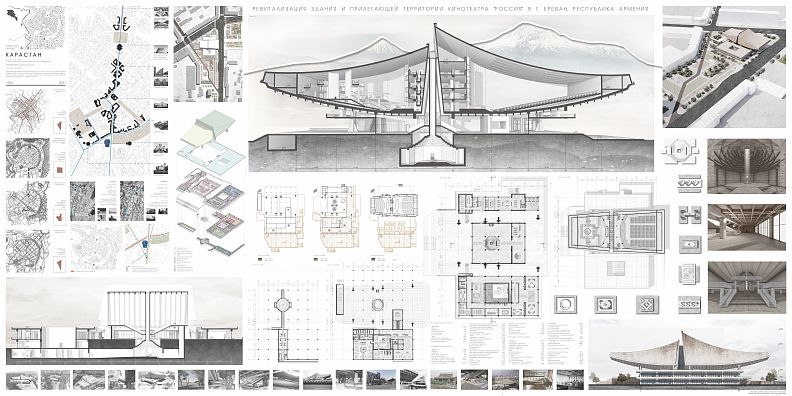Sacralization of monuments of Soviet Modernism on the example of the cinema "Russia" in Yerevan

Idea projektu
The main purpose of this work is to rethink the historical and cultural value of the object of the Soviet architectural heritage, to design a cultural center, reconstructing the building of the former cinema "Russia" in Yerevan again and restoring its original appearance. The design should be based on the peculiarities of the Armenian history and culture.
The object of the study is the building of the former cinema "Russia", designed by Tarkhanian, Poghosian and Khachikian.
The subject of the research is the system of symbolic interpretations; the cultural center; the cultural code of the Armenian nation.
The purpose of the study is to give a sociological interpretation to the cinema building. This means that this object is considered from the point of view of the idea of architecture as a language. That is, the building does not act as a material object that performs specific functions and tasks, but as the personification of a symbolic system formed due to various historical, political, economic and social upheavals. In this context, the former cinema "Russia" is an architectural object as a text, as a cascade of meanings, as a "society in stone".
In the course of the work, the history of the building, its structure are studied, multiple semantic aspects are revealed. The article analyzes the changes in the studied architectural space, its functional content in the context of historical transformations. For this purpose, a historical analysis of the general plan of Yerevan was carried out. As a result, it was revealed that the cinema building and the surrounding area play an important role in the urban planning system of the city.
The result was the development of a cultural center in the inner space of the building with a variety of new functions and the development of the adjacent territory as a new recreational space-a"hinge" that combines the main ring boulevard of the eastern part of the city with the green spaces of the western part. The main emphasis is on the inviolability of the original appearance, the creation of a new green frame of the city and on the semantic nuances embodied in the elements of architectural space and interior.
Popis projektu
The study is based on several methods. The first way is to rethink the object. The cinema "Russia" does not act as a material object, but as the embodiment of a symbolic system.
The building generates a plural number of meanings. This is a kind of manifesto of the Armenian national identity. And even more, this building is the complete embodiment of the life of Armenia over the past hundred years. After all, any change in both the cultural and social life of the country has been reflected in the internal and external appearance of the building and public space. It is like the heart of not only the capital, but the country. It stores historical memory. And the conversations about the demolition of this object that arise in society seem impossible. The possible loss of this object can lead to irreparable serious consequences for the culture of the country, for society. Therefore, it is important to study the object from different sides.
The first aspect is imagery. Architects about the silhouette image of the building: "We remembered Marmashen. Two identical churches of different sizes stand side by side. There is a "working" space between them. Or at the academy in Haghpat - also a transition to two similar ones. Having" dispersed", the halls created a dynamic silhouette of concave planes rising towards each other. This decision is metaphorical and causes different sensations (in the contour of the two halls, someone can see the double head of Mount Ararat - is that why, when renaming the cinema, they turned to the name Ayrarat). But regardless of the perception, we managed to achieve very significant results in the development of the form here."
As you know, the idea of the "spirit of the place" in the master plan was lost and now in the historical center of Mount Ararat can be clearly traced only from the Cascade in the north of the city. Since the cinema is located exactly on that historical axis, it takes on a new meaning. Now the cinema building is probably the only prototype of Ararat that we can see moving south from Republic Square. Then the north-south urban planning axis acquires a new idea. The movement both begins with Ararat and ends with it. This is the cultural code of the nation in the space of the city, as well as memory, faith in the future and all the national pain, because Mount Ararat occupies an important place in the life of every Armenian, but it does not belong to Armenia geographically. It is located on the territory of Turkey, the borders with which are closed. It is physically inaccessible to the citizens of Armenia, only its outline is visible, so the longing increases every day. And criticism of the cinema building due to the simplicity of forms and the lack of details is inappropriate. If for us the cinema acts as a prototype of Ararat, then both the silhouette and the purity of the building's volumes are dictated by the factor of the incomprehensibility of the mountain itself. Both from the Cascade and in the building, we see only the outlines of the mountain. This is the sad symbolism of the architectural image.
It is important to pay attention to the urban planning location of the building relative to the cardinal directions, namely to the West and to the East. This also has a connection with the historical fate of the country. Armenia, due to its geographical location, has always become a place of collision of the great empires of the West and the East. More often, this stopped the cultural development of the country for centuries, leaving only ruins behind. But, despite everything, the Armenian people have preserved and continue to remain faithful to their culture. The endless confrontation only strengthened the faith. Loyalty became the core of the spiritual life of the people.
The monument of this confrontation in the building is the space between the two cinema halls, which becomes a place of power, where culture is reborn from the ashes.
In the modern period, the influence of the West and the East is also present. This is manifested more in the political orientation of the state, in the influence of the Armenian diaspora in the United States, Europe and Russia, which still leaves its mark on the public life of the country. And even the fact that it is the larger cinema hall of the building that is directed to the East indicates a stronger influence of this side.
Thus, every detail of the building carries a certain meaning, which is unshakably connected with the country. There is a complete dematerialization of the architectural object.
The next method of research is the study of historical facts and conducting surveys of the country's population.
Artur Tarkhanyan has always dreamed of designing a church. "He said that he was never able to design a church, but here he succeeded. The center of the cinema "Russia", especially in the evenings, attracted the attention of visitors with its ceiling. It was Dad's pride. Looking up, visitors saw the starry sky. He told me :" You know, I dream that the audience will come, raise their heads and see the stars...", - said Tarkhanian.
The author himself attached a certain sacred and religious significance to the space between the halls. That is why this will be taken into account in the further development of the design solution. It is important to follow the language of cinema architects. This stores the memory and value of the object.
When conducting surveys among the Armenian population of various ages, 88 % of respondents said that they would like to see this object in the previous architectural interpretation, 12 % would leave it so. Many noted that they are dissatisfied with the "marketability" of this public space, that they would like to organize new green zones, since it is uncomfortable to walk on the territory in the hot season. Also, residents who visited the cinema before closing noted the attractiveness and importance of the space in the lobby under the stairs leading to the cinema halls, and especially the octagonal bar. This was a favorite place for cinema visitors.
Technické informace
The building is now a cultural complex that includes the functions of a museum, a restaurant, a coworking, a library, a shopping space, an educational center, an exhibition space, an office, a congress hall and a public terrace.
According to the levels, the architectural object consists of five blocks.
The first block-level-4.200. Rebirth. It is a sacred complex consisting of two zones. The first zone is a museum, it tells about the outstanding personalities of the Armenian Diaspora. The second zone is sacred. The ceiling is made in the form of one element of traditional Armenian housing-azarashen. This is a domed architectural detail consisting of several tiers of rectangles and octahedrons tapering upwards. It symbolizes the movement towards the light, rebirth. There are 3 stages around this space, each of which represents the pain of the Armenian people, namely the 1988 Spitak earthquake, the First and Second Artsakh Wars. The main message is that the revival of national strength is based on acceptance and awareness of pain, on unification. The exit can only be in a straight direction, neither to the west nor to the east, only up.
The second block is level 0.000. It includes three sub-blocks (a restaurant, a patio with a coworking space and an open library, a shopping space). The restaurant is the "Memory of the Building". The octagonal bar, which was located in the lobby during the operation of the cinema, is being restored in it. The retail space is a "Compromise". Since trade has always been present in this territory, it is important to preserve it. But in this case, it is used only for the sale of Armenian-made goods. The patio is a "hearth". The personification of the power of the Armenian family, which influences the formation of national culture, as the "generator" of the entire building.
The third block is level 3.750. Catharsis. It consists of an administrative block with an open-type office, a foyer with an exhibition function, an educational center and an exhibition space. The meaning is to purify the national culture. To do this, multiple processes are running.
The fourth block is level 7.600. A public terrace with recreational areas.
The fifth block is level 15.400. It consists of two blocks. One hall was transformed with the help of levels and staircases into the "12 Capitals" museum, the second hall now functions as a congress hall.














